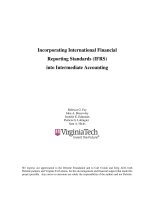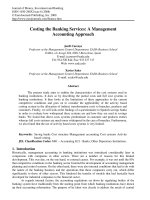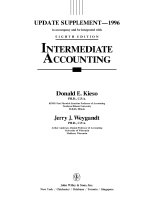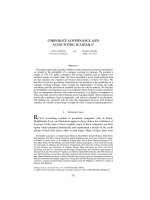Intermediate Accounting - Chap012 pot
Bạn đang xem bản rút gọn của tài liệu. Xem và tải ngay bản đầy đủ của tài liệu tại đây (1.72 MB, 52 trang )
Copyright © 2007 by The McGraw-Hill Companies, Inc. All rights reserved.
Investments
12
12-2
Accounting for Investment Securities
Bonds and
notes
(Debt
securities)
Bonds and
notes
(Debt
securities)
Common and
preferred stock
(Equity
(Equity
securities)
securities)
Common and
preferred stock
(Equity
(Equity
securities)
securities)
Investments can be accounted for in a
variety of ways, depending on the nature
of the investment relationship.
12-3
Reporting Categories for Investments
12-4
Learning Objectives
Demonstrate how to identify and account for
investments classified for reporting purposes
as held to maturity.
12-5
Trading securities
Trading securities
(TS) are bought and
(TS) are bought and
held primarily to be
held primarily to be
sold in the near term.
sold in the near term.
Trading securities
Trading securities
(TS) are bought and
(TS) are bought and
held primarily to be
held primarily to be
sold in the near term.
sold in the near term.
Securities available
Securities available
for sale (SAS) are
for sale (SAS) are
expected to be held
expected to be held
for an unspecified
for an unspecified
period of time.
period of time.
Securities available
Securities available
for sale (SAS) are
for sale (SAS) are
expected to be held
expected to be held
for an unspecified
for an unspecified
period of time.
period of time.
Reporting Categories for Investments
Held-to-maturity
Held-to-maturity
(HTM) securities
(HTM) securities
are investments in
are investments in
debt the investor
debt the investor
intends and has
intends and has
the ability to hold
the ability to hold
until they mature.
until they mature.
Held-to-maturity
Held-to-maturity
(HTM) securities
(HTM) securities
are investments in
are investments in
debt the investor
debt the investor
intends and has
intends and has
the ability to hold
the ability to hold
until they mature.
until they mature.
12-6
Securities to Be Held to Maturity
On January 1, 2006, Matrix, Inc. purchased as an investment
$1,000,000, of 10%, 10-year bonds, interest paid semi-
annually. The market rate for similar bonds is 12%, so Matrix
paid $885,301 for the bonds. Let’s look at the required
journal entries.
$885,301
$885,301
× (12% ÷ 2) = $53,118
× (12% ÷ 2) = $53,118
$885,301
$885,301
× (12% ÷ 2) = $53,118
× (12% ÷ 2) = $53,118
12-7
Securities to Be Held to Maturity
$114,699 - $3,118 = $111,581 unamortized discount
$114,699 - $3,118 = $111,581 unamortized discount
On January 1, 2006, Matrix, Inc. purchased as an investment
$1,000,000, of 10%, 10-year bonds, interest paid semi-
annually. The market rate for similar bonds is 12%, so Matrix
paid $885,301 for the bonds. Let’s look at the required
journal entries.
12-8
Investments Held for an Unspecified Period of Time
When an investment is held for an unspecified
period of time, it is reported at the fair value of the
security on the reporting date.
When an investment is held for an unspecified
period of time, it is reported at the fair value of the
security on the reporting date.
Must be “readily
determinable”
Must be “readily
determinable”
Otherwise, the
investment is
reported at cost.
Otherwise, the
investment is
reported at cost.
.
12-9
Learning Objectives
Demonstrate how to identify and account for
investments classified for reporting purposes
as available-for-sale.
12-10
Securities Available-for-Sale
Adjustments to fair value
Adjustments to fair value
are recorded as:
are recorded as:
1.
1.
a direct adjustment to the
a direct adjustment to the
investment account, and
investment account, and
2.
2.
an allowance account in
an allowance account in
the equity section of the
the equity section of the
balance sheet called “
balance sheet called “
Net
Net
Unrealized Holding
Unrealized Holding
Gains/Losses
Gains/Losses
”.
”.
Adjustments to fair value
Adjustments to fair value
are recorded as:
are recorded as:
1.
1.
a direct adjustment to the
a direct adjustment to the
investment account, and
investment account, and
2.
2.
an allowance account in
an allowance account in
the equity section of the
the equity section of the
balance sheet called “
balance sheet called “
Net
Net
Unrealized Holding
Unrealized Holding
Gains/Losses
Gains/Losses
”.
”.
12-11
Securities Available for Sale Example
Matrix, Inc. purchased the securities listed below in
Matrix, Inc. purchased the securities listed below in
2006. They are classified as Securities Available
2006. They are classified as Securities Available
for Sale (SAS). The fair value of the securities
for Sale (SAS). The fair value of the securities
were determined on December 31, 2006. Prepare
were determined on December 31, 2006. Prepare
the journal entries for Matrix, Inc. to adjust the
the journal entries for Matrix, Inc. to adjust the
securities to fair value at December 31, 2006.
securities to fair value at December 31, 2006.
Matrix, Inc. purchased the securities listed below in
Matrix, Inc. purchased the securities listed below in
2006. They are classified as Securities Available
2006. They are classified as Securities Available
for Sale (SAS). The fair value of the securities
for Sale (SAS). The fair value of the securities
were determined on December 31, 2006. Prepare
were determined on December 31, 2006. Prepare
the journal entries for Matrix, Inc. to adjust the
the journal entries for Matrix, Inc. to adjust the
securities to fair value at December 31, 2006.
securities to fair value at December 31, 2006.
12-12
Securities Available for Sale Example
.
This net unrealized holding gain is
reported as an allowance in the equity
section of the balance sheet.
This net unrealized holding gain is
reported as an allowance in the equity
section of the balance sheet.
12-13
Other Comprehensive Income
When we add
When we add
other comprehensive income
other comprehensive income
to
to
net income
net income
we refer to the result as “comprehensive income.”
we refer to the result as “comprehensive income.”
When we add
When we add
other comprehensive income
other comprehensive income
to
to
net income
net income
we refer to the result as “comprehensive income.”
we refer to the result as “comprehensive income.”
12-14
Securities Available for Sale
Net unrealized holding gains and losses from securities
available-for-sale are reported in the equity section of
the balance sheet.
12-15
Securities Available for Sale
This is called . . .
Occasionally, an
Occasionally, an
investment’s value
investment’s value
will decline for
will decline for
reasons that are
reasons that are
“other than
“other than
temporary”.
temporary”.
Occasionally, an
Occasionally, an
investment’s value
investment’s value
will decline for
will decline for
reasons that are
reasons that are
“other than
“other than
temporary”.
temporary”.
12-16
Securities Available for Sale
The new cost
The new cost
basis (the
basis (the
impaired fair
impaired fair
value) is not
value) is not
changed for
changed for
subsequent
subsequent
recoveries in
recoveries in
fair value.
fair value.
The new cost
The new cost
basis (the
basis (the
impaired fair
impaired fair
value) is not
value) is not
changed for
changed for
subsequent
subsequent
recoveries in
recoveries in
fair value.
fair value.
If the value is
impaired . . .
. . . the recorded cost of
the security is reduced
to the
impaired fair
impaired fair
value
value, and the
difference is included in
the current period’s
income.
If the value is
impaired . . .
. . . the recorded cost of
the security is reduced
to the
impaired fair
impaired fair
value
value, and the
difference is included in
the current period’s
income.
12-17
Learning Objectives
Demonstrate how to identify and account for
investments classified for reporting purposes
as trading securities.
12-18
Trading Securities
Adjustments to fair
Adjustments to fair
value are recorded
value are recorded
as:
as:
1.
1.
a direct adjustment to
a direct adjustment to
the investment
the investment
account, and
account, and
2.
2.
a net unrealized
a net unrealized
holding gain/loss on
holding gain/loss on
the
the
Income
Income
Statement
Statement
.
.
Adjustments to fair
Adjustments to fair
value are recorded
value are recorded
as:
as:
1.
1.
a direct adjustment to
a direct adjustment to
the investment
the investment
account, and
account, and
2.
2.
a net unrealized
a net unrealized
holding gain/loss on
holding gain/loss on
the
the
Income
Income
Statement
Statement
.
.
12-19
Trading Securities
Matrix, Inc. purchased the addition securities classified
Matrix, Inc. purchased the addition securities classified
as Trading Securities (TS) in 2006. The fair value
as Trading Securities (TS) in 2006. The fair value
amounts were determined on December 31, 2006.
amounts were determined on December 31, 2006.
Prepare the journal entries for Matrix, Inc. to adjust
Prepare the journal entries for Matrix, Inc. to adjust
the securities to fair value at 12/31/06.
the securities to fair value at 12/31/06.
Matrix, Inc. purchased the addition securities classified
Matrix, Inc. purchased the addition securities classified
as Trading Securities (TS) in 2006. The fair value
as Trading Securities (TS) in 2006. The fair value
amounts were determined on December 31, 2006.
amounts were determined on December 31, 2006.
Prepare the journal entries for Matrix, Inc. to adjust
Prepare the journal entries for Matrix, Inc. to adjust
the securities to fair value at 12/31/06.
the securities to fair value at 12/31/06.
12-20
Trading Securities
The Net Unrealized Holding Loss is
reported on the Income Statement.
The Net Unrealized Holding Loss is
reported on the Income Statement.
12-21
Trading Securities
Unrealized
holding
gains and
losses from
trading
securities
are reported
on the
income
statement.
12-22
Transfers Between Reporting Categories
Unrealized holding
gains or losses at
reclassification should
be accounted for in a
manner consistent
with the classification
into which the security
is being transferred.
Unrealized holding
gains or losses at
reclassification should
be accounted for in a
manner consistent
with the classification
into which the security
is being transferred.
Transfers are
accounted for
at
fair value
fair value
on the
transfer date.
Transfers are
accounted for
at
fair value
fair value
on the
transfer date.
12-23
Disclosures
12-24
Learning Objectives
Explain what constitutes significant influence
by the investor over the operating and financial
policies of the investee.
12-25









